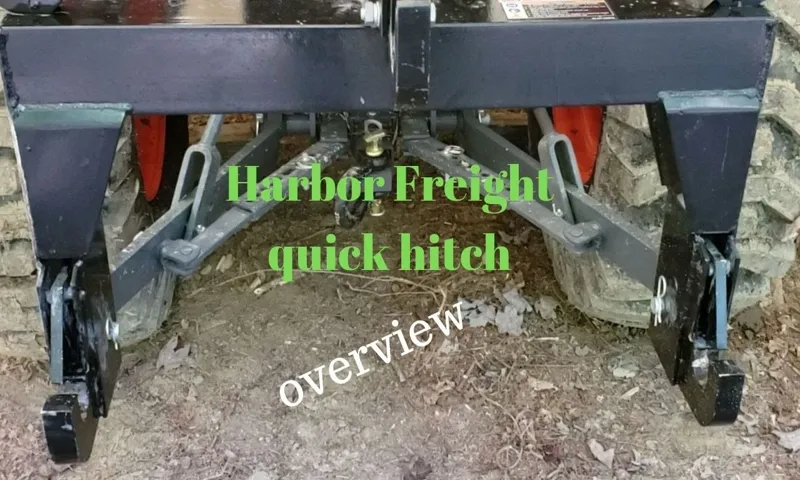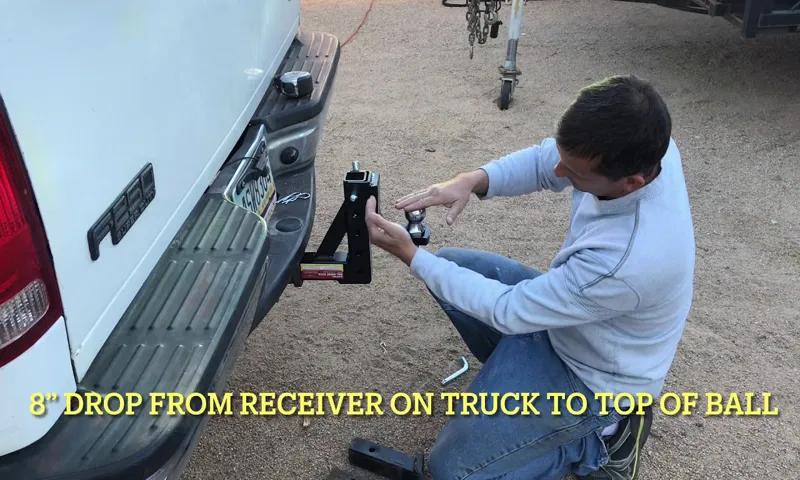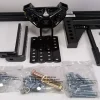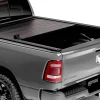Do you own a trailer and frequently tow it with your vehicle? If so, you probably understand the importance of having a well-adjusted equalizer hitch. An equalizer hitch, also known as a weight distribution hitch, helps distribute the weight of the trailer evenly across all tires of the towing vehicle, improving stability and control while on the road. One popular equalizer hitch option is the Harbor Freight Equalizer Hitch.
While this hitch is affordable and effective, it requires proper adjustment to ensure optimal performance. Adjusting a Harbor Freight Equalizer Hitch may seem daunting at first, but with a little knowledge and the right tools, you can do it yourself and save money on professional installation. In this blog post, we will guide you through the process of adjusting a Harbor Freight Equalizer Hitch step by step.
We will cover everything from understanding the different components of the hitch to setting the correct height and tension. By the end of this post, you will have the knowledge and confidence to adjust your Harbor Freight Equalizer Hitch like a pro. So, let’s get started!
Table of Contents
- 1 Introduction
- 2 Step-by-Step Guide on Adjusting a Harbor Freight Equalizer Hitch
- 2.1 Step 1: Prepare the necessary tools and equipment
- 2.2 Step 2: Loosen the bolts on the hitch assembly
- 2.3 Step 3: Adjust the height of the hitch head
- 2.4 Step 4: Align the hitch head with the trailer coupler
- 2.5 Step 5: Tighten the bolts on the hitch assembly
- 2.6 Step 6: Test the hitch and make necessary adjustments
- 3 Conclusion
- 4 FAQs
Introduction
If you own a trailer and frequently tow heavy loads, having an equalizer hitch can greatly improve the stability and control of your vehicle. Harbor Freight is a popular brand that offers affordable and reliable equalizer hitches. However, adjusting the hitch to suit your specific towing needs can be a bit confusing for beginners.
But fear not, because in this blog post, I will guide you through the process of adjusting a Harbor Freight equalizer hitch step by step, making it easy for you to achieve a safe and smooth towing experience. So, let’s dive in and learn how to adjust a Harbor Freight equalizer hitch like a pro!
What is a Harbor Freight Equalizer Hitch?
Harbor Freight Equalizer Hitch Introduction When it comes to towing heavy loads, having the right equipment is essential for a safe and smooth journey. One such tool that can greatly enhance your towing experience is a Harbor Freight equalizer hitch. But what exactly is a Harbor Freight equalizer hitch and how does it work? In this blog post, we will explore the ins and outs of this handy piece of equipment and why it’s a must-have for any serious towing enthusiast.
So buckle up, because we’re about to dive into the world of Harbor Freight equalizer hitches.

Why do you need to adjust a Harbor Freight Equalizer Hitch?
harbor freight equalizer hitch, adjust
Safety Precautions
Safety Precautions Introduction When it comes to ensuring our safety in various aspects of life, whether at home or at work, it is crucial to take necessary precautions. Safety precautions are measures put in place to prevent accidents and protect individuals from harm. These precautions encompass a wide range of practices and guidelines that need to be followed diligently.
From wearing safety gear to practicing good housekeeping, each precaution plays a vital role in maintaining a safe environment. In this blog section, we will explore some common safety precautions that are essential in different settings and how they can help us stay safe and secure. So, let’s dive in and discover the importance of safety precautions in our daily lives.
Step-by-Step Guide on Adjusting a Harbor Freight Equalizer Hitch
Do you have a Harbor Freight equalizer hitch that needs adjusting? Don’t worry, it’s actually a fairly straightforward process. First, you’ll want to start by parking your trailer on a level surface and disconnecting it from your towing vehicle. Next, locate the adjustable brackets on the hitch assembly and use a wrench to loosen the bolts.
This will allow you to adjust the height of the hitch head. Once the height is set, tighten the bolts to secure it in place. Now, it’s time to adjust the tension on the bars.
Start by releasing the tension using the handle on the hitch head. Then, use a pry bar to adjust the position of the spring bars. You’ll want to make sure they are parallel to the frame of the trailer.
Finally, reapply tension using the handle and check that everything is secure before reattaching the trailer to your towing vehicle. And there you have it! With a few simple steps, you can easily adjust your Harbor Freight equalizer hitch to ensure a smoother and safer towing experience.
Step 1: Prepare the necessary tools and equipment
harbor freight equalizer hitch, adjusting a harbor freight equalizer hitch, tools and equipment, step-by-step guide
Step 2: Loosen the bolts on the hitch assembly
Harbor Freight, equalizer hitch, adjustable, bolts, loosen So you’ve got your Harbor Freight equalizer hitch and you’re ready to hit the road. But before you can tow your trailer with ease, you need to make sure the hitch is properly adjusted. One of the first steps in this process is to loosen the bolts on the hitch assembly.
This will allow you to make any necessary adjustments to ensure that the weight of your trailer is distributed evenly between your tow vehicle and trailer. To begin, locate the bolts that secure the hitch assembly to the frame of your tow vehicle. Using a socket wrench or adjustable wrench, start by loosening each bolt one at a time.
Be sure to keep track of the bolts as you loosen them, as you will need to tighten them again later. As you loosen the bolts, you may need to use some force to break them free if they are tight. This is normal, but be careful not to strip the threads or damage the bolts or hitch assembly.
Take your time and apply steady, even pressure until each bolt is loose enough to remove by hand. Once all of the bolts are loosened, you can begin making the necessary adjustments to the hitch assembly. This may involve moving the hitch head up or down, or adjusting the angle of the weight distribution bars.
Refer to the instructions provided by Harbor Freight for your specific hitch model to ensure you make the correct adjustments. After you have made the necessary adjustments, it’s time to tighten the bolts back down. Again, use your socket wrench or adjustable wrench to carefully tighten each bolt, making sure not to overtighten or cross-thread them.
By loosening and adjusting the bolts on your Harbor Freight equalizer hitch, you are taking the first step in ensuring a smooth and safe towing experience. Remember to always consult the instructions provided by Harbor Freight and take your time to make the proper adjustments. With a little bit of patience and know-how, you’ll be ready to hit the road in no time.
Step 3: Adjust the height of the hitch head
When it comes to towing heavy loads, having an adjustable hitch head is essential for ensuring a smooth and safe journey. One popular option is the Harbor Freight Equalizer Hitch, which allows you to adjust the height of the hitch head to match the height of your trailer. This is important because if the hitch head is too high or too low, it can cause instability and make towing more difficult.
So, how exactly do you adjust the height of the hitch head on a Harbor Freight Equalizer Hitch? Let’s break it down step by step. Step 3: Adjust the height of the hitch head. To adjust the height of the hitch head, you’ll first need to find the appropriate hole on the shank of the hitch to attach the hitch head.
The shank typically has multiple holes at different heights to accommodate different trailer heights. Start by lifting the hitch head off the shank, and then align the holes on the hitch head with the desired height on the shank. Once aligned, place the hitch head back onto the shank and secure it with the provided pins or bolts.
Next, check the height of the trailer coupling and ensure that it is level with the hitch head. If the trailer coupling is too low, you may need to lower the height of the hitch head by removing it from the shank and placing it in a lower hole. Conversely, if the trailer coupling is too high, you may need to raise the height of the hitch head by moving it to a higher hole.
It’s important to note that when adjusting the height of the hitch head, you should also consider the weight distribution of your trailer. Ideally, you want the trailer to be level when it is hooked up to the hitch. If the front of the trailer is too high or too low, you may need to adjust the weight distribution bars or add/remove weight from the front or back of the trailer to achieve proper balance.
By following these steps to adjust the height of the hitch head on your Harbor Freight Equalizer Hitch, you’ll be able to tow your trailer safely and efficiently. Remember to double-check the height and weight distribution before hitting the road to ensure a smooth and worry-free towing experience. Happy towing!
Step 4: Align the hitch head with the trailer coupler
In this step-by-step guide, we will walk you through the process of adjusting a Harbor Freight equalizer hitch. Step 4 involves aligning the hitch head with the trailer coupler. This is an essential step in order to ensure a secure connection between your towing vehicle and the trailer.
To align the hitch head with the trailer coupler, start by making sure both the tow vehicle and the trailer are on a level surface. Next, lower the trailer coupler onto the hitch ball, making sure it is seated properly. Once the coupler is on the hitch ball, you will need to adjust the height of the hitch head.
This can be done by using the height adjustment mechanism on the equalizer hitch. Raise or lower the hitch head until it is at the same level as the trailer coupler. It’s important to note that the height of the hitch head should be adjusted so that the trailer is level when attached to the tow vehicle.
This will help ensure proper weight distribution and towing stability. Once the hitch head is at the correct height, you can secure it using the appropriate fasteners or locking mechanisms provided with the equalizer hitch. Double-check that all connections are tight and secure before moving on to the next step.
Taking the time to properly align the hitch head with the trailer coupler will ensure a safe and reliable towing experience. It is important to follow these steps carefully and consult the manufacturer’s instructions for your specific equalizer hitch model.
Step 5: Tighten the bolts on the hitch assembly
adjusting a Harbor Freight equalizer hitch
Step 6: Test the hitch and make necessary adjustments
Harbor Freight equalizer hitches are a popular choice for towing, as they help distribute the weight evenly between the tow vehicle and the trailer. However, even the best hitch setup may require some adjustments to ensure optimal towing performance and safety. In this step 6 of the guide, we will discuss how to test the hitch and make any necessary adjustments.
Once you have installed the Harbor Freight equalizer hitch and connected your trailer, it’s time to put it to the test. Take your time and drive slowly on a flat surface to get a feel for how the hitch performs. Pay close attention to the trailer’s movement and the reaction of the tow vehicle.
If you notice any swaying or instability, it may be an indication that the hitch needs adjustment. Start by checking the weight distribution bars and making sure they are properly tensioned. If they are too loose, the weight may not be properly distributed, leading to instability.
On the other hand, if they are too tight, they may put too much pressure on the tow vehicle, affecting its handling. Next, take a look at the ball mount and make sure it is properly torqued. This ensures a secure connection between the hitch and the trailer, reducing the chances of any movement or separation while towing.
Additionally, check the coupler and safety chains to make sure they are properly attached and secured. During the test, pay attention to any unusual noises or vibrations. These could be signs of improper weight distribution or issues with the hitch setup.
If you notice anything out of the ordinary, it’s best to consult the instructions provided by Harbor Freight or seek professional help to diagnose and rectify the problem. Remember, towing safety is paramount, and it’s important to always test your hitch setup before embarking on a journey. By carefully and systematically testing the hitch and making necessary adjustments, you can ensure a smooth and secure towing experience.
Conclusion
So there you have it – a step-by-step guide on how to adjust a Harbor Freight equalizer hitch. Now, you might be thinking, why on earth would anyone need such a guide? Well, let me fill you in on a little secret. Equalizer hitches, while incredibly useful and essential for towing heavy loads, can be a bit tricky to get just right.
And that’s where this guide comes in. It breaks down the process into simple, manageable steps, making it easier than ever to achieve that perfect balance. Now, I know what you’re thinking – Harbor Freight, really? Can I trust them to provide quality products? Well, that’s a fair question.
But let me assure you, while Harbor Freight may have a reputation for being a bit, shall we say, budget-friendly, their equalizer hitches are no joke. Sure, you might have to put in a little extra effort to adjust it properly, but once you do, it’ll be smooth sailing on the open road. You’ll feel like a master of balance and control, effortlessly gliding down the highway with your fully loaded trailer in tow.
People will marvel at your hitch-adjusting prowess, wondering how you managed to make it look so easy. But remember, with great power comes great responsibility. Just because you now know how to adjust a Harbor Freight equalizer hitch doesn’t mean you should go around towing everything in sight.
Use your newfound knowledge wisely, and only tow what your vehicle and hitch can handle. Safety should always be your top priority. So go forth, my fellow adventurers.
Hitch up your trailers, adjust those hitches, and embark on epic journeys with confidence. The open road awaits, and now, thanks to this guide, you’ll be ready to conquer it like never before. Happy towing!”
Final Thoughts
adjusting a Harbor Freight equalizer hitch
Additional Tips and Considerations
Harbor Freight equalizer hitch, adjusting a Harbor Freight equalizer hitch, step-by-step guide Adjusting a Harbor Freight equalizer hitch can be a bit daunting, especially if you’re not familiar with the process. However, with a step-by-step guide, you can easily make the necessary adjustments to ensure a smooth and safe towing experience. The first step in adjusting a Harbor Freight equalizer hitch is to determine the proper weight distribution.
This involves weighing your trailer and tow vehicle to calculate the tongue weight. Once you have this information, you can adjust the hitch by adding or removing weight from the spring bars. Next, it’s important to properly set the hitch height.
This can be done by measuring from the ground to the top of the hitch ball and then adjusting the height of the hitch head accordingly. This will ensure that the trailer is level when attached to the tow vehicle. Once the hitch height is set, it’s time to adjust the tilt of the head.
This can be done by loosening the bolts on the head assembly and tilting it to the desired angle. It’s important to note that the head should be tilted slightly forward to put more weight on the front tires of the tow vehicle for improved steering and stability. After adjusting the height and tilt of the head, it’s time to fine-tune the weight distribution.
This can be done by adjusting the tension on the spring bars. The goal is to transfer enough weight from the rear axle of the tow vehicle to the front axle and the trailer axles for optimal balance and control. To adjust the tension on the spring bars, you will need to use a wrench to tighten or loosen the chains that connect the spring bars to the trailer frame.
It’s important to make small adjustments and test the setup by taking the trailer for a short test drive. This will allow you to make any necessary tweaks before hitting the road. Once you have made all the necessary adjustments, it’s important to double-check everything to ensure that the hitch is properly set up.
FAQs
How do I adjust the height of a Harbor Freight equalizer hitch?
To adjust the height of a Harbor Freight equalizer hitch, you can use the included wrench to loosen the bolts on the adjustment plate. Once the bolts are loose, you can raise or lower the hitch head to the desired position and tighten the bolts back up.
What tools do I need to adjust a Harbor Freight equalizer hitch?
To adjust a Harbor Freight equalizer hitch, you will need a wrench or socket set to loosen and tighten the adjustment bolts. You may also need a measuring tape or level to ensure that the hitch is adjusted to the correct height.
How often should I adjust the tension on a Harbor Freight equalizer hitch?
The tension on a Harbor Freight equalizer hitch should be checked and adjusted before each towing trip. This ensures that the weight distribution and sway control functions are working properly and can help prevent any issues while on the road.
Can I adjust the weight distribution on a Harbor Freight equalizer hitch?
Yes, you can adjust the weight distribution on a Harbor Freight equalizer hitch. The adjustable spring bars allow you to change the tension and distribute the weight between the tow vehicle and trailer for improved stability and control.
What is the maximum towing capacity of a Harbor Freight equalizer hitch?
The maximum towing capacity of a Harbor Freight equalizer hitch can vary depending on the specific model and configuration. It is important to refer to the manufacturer’s instructions and guidelines to ensure that you do not exceed the recommended weight limits.
How do I know if my Harbor Freight equalizer hitch is properly adjusted?
A properly adjusted Harbor Freight equalizer hitch will distribute the weight evenly between the tow vehicle and trailer, keeping the vehicle level and minimizing sway. You can check the adjustments by visually inspecting the hitch and trailer while connected and by monitoring the handling and stability while towing.
Can I adjust the sway control on a Harbor Freight equalizer hitch?
Yes, the sway control on a Harbor Freight equalizer hitch can be adjusted. The tension on the sway control bar can be increased or decreased to help minimize trailer sway during towing. It is important to adjust the sway control properly to ensure safe and stable towing.



